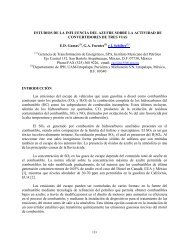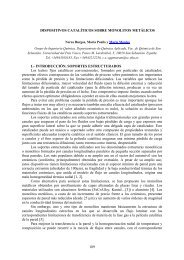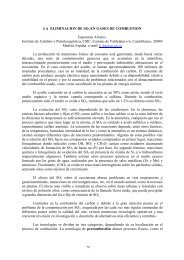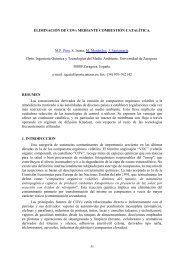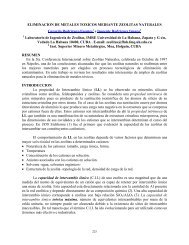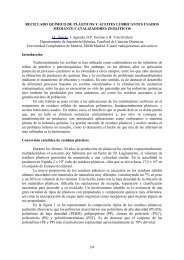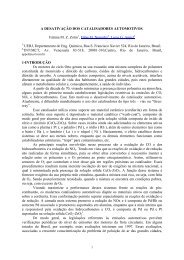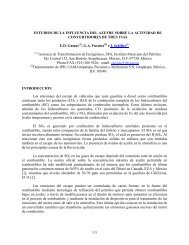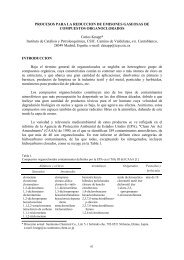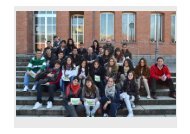Click reactions in protein chemistry - Instituto de Catálisis y ...
Click reactions in protein chemistry - Instituto de Catálisis y ...
Click reactions in protein chemistry - Instituto de Catálisis y ...
Create successful ePaper yourself
Turn your PDF publications into a flip-book with our unique Google optimized e-Paper software.
Organic &BiomolecularChemistrywww.rsc.org/obc Volume 10 | Number 47 | 21 December 2012 | Pages 9297–9508ISSN 1477-0520PERSPECTIVEJose M. Palomo<strong>Click</strong> <strong>reactions</strong> <strong>in</strong> prote<strong>in</strong> <strong>chemistry</strong>: from the preparation of semisyntheticenzymes to new click enzymes
Organic &BiomolecularChemistryCite this: Org. Biomol. Chem., 2012, 10, 9309www.rsc.org/obcDynamic Article L<strong>in</strong>ksPERSPECTIVE<strong>Click</strong> <strong>reactions</strong> <strong>in</strong> prote<strong>in</strong> <strong>chemistry</strong>: from the preparation of semisyntheticenzymes to new click enzymesJose M. Palomo*Received 19th July 2012, Accepted 11th September 2012DOI: 10.1039/c2ob26409a<strong>Click</strong>-<strong>chemistry</strong> is an approach based on cycloaddition <strong>reactions</strong> which has been successfully used as achemical approach for complex organic molecules and which has recently starred <strong>in</strong> a boom <strong>in</strong> the worldof prote<strong>in</strong> <strong>chemistry</strong>. The advantage of the use of this technique <strong>in</strong> prote<strong>in</strong> <strong>chemistry</strong> is based on a veryhigh and efficient chemoselectivity, which usually requires simple or no purification and is extremelyrate-accelerated <strong>in</strong> aqueous media. The perspective discusses some of the most recent advances <strong>in</strong> theapplication of this reaction <strong>in</strong> selective enzyme surface modification for the creation of new semisyntheticenzymes (fluorescence labeled enzymes, pepti<strong>de</strong>-enzyme conjugates, glycosylated enzymes), and<strong>in</strong>terest<strong>in</strong>gly, the recent <strong>de</strong>sign and creation of “click” enzymes.IntroductionThe click <strong>chemistry</strong> concept, <strong>in</strong>troduced by Barry Sharpless <strong>in</strong>2001, <strong>de</strong>scribes the <strong>chemistry</strong> of tailored <strong>reactions</strong> to generatecompounds quickly and easily by jo<strong>in</strong><strong>in</strong>g small units un<strong>de</strong>r verysimple reaction conditions. 1 Several efficient <strong>reactions</strong>, whichare capable of produc<strong>in</strong>g a wi<strong>de</strong> catalogue of functional syntheticmolecules and organic materials, have been grouped accord<strong>in</strong>glyDepartamento <strong>de</strong> Biocatálisis. <strong>Instituto</strong> <strong>de</strong> <strong>Catálisis</strong> (CSIC). C/ MarieCurie 2. Cantoblanco. Campus UAM, 28049 Madrid, Spa<strong>in</strong>.E-mail: josempalomo@icp.csic.es; Fax: +34-91 585 47 60un<strong>de</strong>r the term click <strong>reactions</strong>. Characteristics of modular click<strong>reactions</strong> <strong>in</strong>clu<strong>de</strong> mild, high-yield<strong>in</strong>g, high-selective, reliable,and clean transformations of broad scope that usually requiresimple or no purification.Molecular processes consi<strong>de</strong>red to fit all or most of these criteria<strong>in</strong>clu<strong>de</strong> certa<strong>in</strong> cycloaddition <strong>reactions</strong>, such as the Huisgen1,3-dipolar azi<strong>de</strong>–alkyne 2 and the Diels–Al<strong>de</strong>r cycloaddition 3and other methods such as the Staud<strong>in</strong>ger ligation 4–6 or thethiol–ene reaction 7,8 (Fig. 1).This click concept has been rapidly applied to biomoleculesmodification, surface functionalization, polymer science, studiesJose M. Palomo received hisPh.D. <strong>de</strong>gree (summa cumlau<strong>de</strong>) <strong>in</strong> 2003 at the AutonomaUniversity of Madrid work<strong>in</strong>gat the Biocatalysis Department<strong>in</strong> Institute of Catalysis (IPC,CSIC) <strong>in</strong> Madrid. For postdoctoralresearch he jo<strong>in</strong>ed theChemical Biology Departmentof Max Planck Institute <strong>in</strong> Dortmund<strong>in</strong> 2004. In 2006, hebegan his appo<strong>in</strong>tment as anAssociate Research Scientist atJose M. Palomo the Biocatalysis Department <strong>in</strong>ICP-CSIC. S<strong>in</strong>ce 2009, he has been a Tenured Scientist (AssociateProfessor) <strong>in</strong> ICP-CSIC. His current research <strong>in</strong>terests<strong>in</strong>clu<strong>de</strong> <strong>de</strong>sign of semisynthetic enzymes, carbohydrate <strong>chemistry</strong>with enzymes, asymmetric biotransformations and immobilizationof biomolecules. Fig. 1 General scheme of click <strong>reactions</strong>.This journal is © The Royal Society of Chemistry 2012 Org. Biomol. Chem., 2012, 10, 9309–9318 | 9309
of biological processes, etc. 9–20 and so relies on easy an<strong>de</strong>fficient coupl<strong>in</strong>g technologies.The copper(I)-catalyzed 1,3-dipolar azi<strong>de</strong>–alkyne cycloaddition(CuAAC), the undisputed lea<strong>de</strong>r among click <strong>chemistry</strong><strong>reactions</strong>, is a quantitative and highly chemoselective reactionbetween an azi<strong>de</strong> group and a term<strong>in</strong>al alkyne group to form atriazole-l<strong>in</strong>ked product. This chemical reaction was <strong>de</strong>scribed byRolf Huisgen as a 1,3-dipolar cycloaddition 2 where the chemicalcoupl<strong>in</strong>g nee<strong>de</strong>d to use high temperature to form the triazolemolecule. Therefore, the discovery of the Cu(I) catalysis permittedthe cycloaddition to proceed with<strong>in</strong> m<strong>in</strong>utes at roomtemperature, open<strong>in</strong>g the door to a broad application, especially<strong>in</strong> biological systems. Sharpless and co-workers and Meldal andco-workers <strong>de</strong>veloped a Cu-catalyzed rendition of this reactionus<strong>in</strong>g term<strong>in</strong>al alkynes as substrates, but the metal’s cytotoxicitylimits its use <strong>in</strong> liv<strong>in</strong>g systems. 21Despite the <strong>de</strong>monstrated reliability of CuAAC for theefficient functionalization of biomacromolecules <strong>in</strong> vitro, thenegative effects of the Cu catalyst have greatly limited its use for<strong>in</strong> vivo applications. Thus, although CuAAC has been used tolabel bacterial 22,23 and mammalian cells, 24,25 the presence of Cuhas often been found to be <strong>de</strong>trimental to liv<strong>in</strong>g cells.Alternatively, benign Cu-free AAC strategies, not requir<strong>in</strong>gcytotoxic metals and additives, have also appeared. The Bertozzigroup has taken advantage of the <strong>in</strong>herent r<strong>in</strong>g stra<strong>in</strong> of cyclooctynesas an effective way for lower<strong>in</strong>g the activation barrier ofAAC and an alternative to the use of metal catalysts (Fig. 1b). 26This stra<strong>in</strong>-promoted AAC variant, SPAAC, has been exploitedas a bioorthogonal strategy for the fluorogenic label<strong>in</strong>g of prote<strong>in</strong>sand is currently used <strong>in</strong> many different chemicalapplications. 27Interest<strong>in</strong>gly, the different reactivity of CuAAC and SPAACcan be used <strong>in</strong> applications where the two processes can beimplemented sequentially for orthogonal and dual-labell<strong>in</strong>gpurposes.Together with it, the Diels–Al<strong>de</strong>r reaction is another quite<strong>in</strong>terest<strong>in</strong>g click reaction. It is a [4π +2π] cycloaddition betweenan electron-rich 1,3-diene and an electron-<strong>de</strong>ficient dienophilelead<strong>in</strong>g to the formation of a six-membered carbocycle (Fig. 1c).This is also a highly selective transformation and <strong>in</strong> water turnedout to be accelerated by a factor up to 10 4 when compared tothat <strong>in</strong> organic solvents. 28These advantages have permitted the employment of thisbioorthogonal methodology <strong>in</strong> pepti<strong>de</strong> and prote<strong>in</strong> <strong>chemistry</strong> andsurface functionalization. 29–33The azi<strong>de</strong>-Staud<strong>in</strong>ger ligation 4 represents another excellentexample of click reaction. Hermann Staud<strong>in</strong>ger 5 <strong>de</strong>scribed thereaction between an azi<strong>de</strong> and a phosph<strong>in</strong>e for the first time <strong>in</strong>1919. However, it was not until recently that the Bertozzi grouprecognized the potential of this reaction as a method for bioconjugationand transformed it <strong>in</strong>to the so-called Staud<strong>in</strong>ger ligation.6 The bio-orthogonal character of both the azi<strong>de</strong> and thephosph<strong>in</strong>e functions has resulted <strong>in</strong> the Staud<strong>in</strong>ger ligationf<strong>in</strong>d<strong>in</strong>g numerous applications <strong>in</strong> cell surface eng<strong>in</strong>eer<strong>in</strong>g, synthesisof pepti<strong>de</strong>s and prote<strong>in</strong>s, prob<strong>in</strong>g post-translational modifications,labell<strong>in</strong>g of glass surfaces or fluorogenic molecules. 34Start<strong>in</strong>g with an ortho-phosph<strong>in</strong>e terephthalic acid <strong>de</strong>rivative,aza-yli<strong>de</strong> is formed through a reaction with azi<strong>de</strong> and un<strong>de</strong>rgoescyclization to give an oxazaphosphetane as an <strong>in</strong>itial<strong>in</strong>termediate. In aqueous media, spontaneous hydrolysis yieldsthe <strong>de</strong>sired ami<strong>de</strong>, <strong>in</strong>to which the phosph<strong>in</strong>e oxi<strong>de</strong> by-product is<strong>in</strong>corporated (Fig. 1d). 6,35,36From a practical standpo<strong>in</strong>t, they showed that basic and morenucleophilic phosph<strong>in</strong>es react faster, however it should be notedthat the very basic aliphatic phosph<strong>in</strong>es are more prone to oxidationlimit<strong>in</strong>g their use <strong>in</strong> biological systems. 37Highly efficient <strong>reactions</strong> of thiols with reactive carbon–carbon double bonds, or simply “enes”, discovered <strong>in</strong> the early1900s, 38 can proceed <strong>in</strong> two different ways: a radical (termedthiol–ene reaction) or an anionic cha<strong>in</strong> (termed thiol Michaeladdition), carry<strong>in</strong>g many of the attributes of click <strong>reactions</strong>(Fig. 1e).This exceptional versatility and its propensity for proceed<strong>in</strong>gto quantitative conversions un<strong>de</strong>r even the mil<strong>de</strong>st of conditionsmake thiol–ene <strong>chemistry</strong> amenable to application <strong>in</strong> bioorganic<strong>chemistry</strong> and biomedic<strong>in</strong>e. The selectivity and high yieldsassociated with the thiol–ene reaction are a perfect marriage withthe requirements of biomaterial applications. Numerous accountsexist <strong>in</strong> the literature on the implementation of the thiol–ene reactionto functionalize biological materials and biological molecules,and to <strong>in</strong>corporate biological molecules <strong>in</strong>to othersynthetic materials and molecules. 39–45Here<strong>in</strong>, the most recent examples of the potential applicationof these click <strong>reactions</strong> on the preparation of new semisyntheticenzymes have been reviewed. The <strong>de</strong>sign and discovery of clickenzymes have also been emphasized <strong>in</strong> the present reviewarticle.<strong>Click</strong>-<strong>chemistry</strong> <strong>in</strong> site-specific modification of enzymesThe <strong>in</strong>troduction of small molecules such as bioorthogonal moietiesis of special relevance for site-specific modification byclick <strong>reactions</strong>. The chemical modification of enzymes us<strong>in</strong>gclick <strong>reactions</strong> has been specially focused on the <strong>in</strong>troduction offluorescent label molecules <strong>in</strong> a different manner, 46–49 or prote<strong>in</strong>post-translational modification such as glycosylation or lipidation<strong>reactions</strong>. 50–55Fluorescent labeled prote<strong>in</strong>s synthesisThe application of new chemical methods for label<strong>in</strong>g prote<strong>in</strong>shave garnered much attention <strong>in</strong> the fields of molecular imag<strong>in</strong>gdue to their straightforward procedures, general applicability, andthe small size of chemical labels, at least relative to the genetically-enco<strong>de</strong>dprote<strong>in</strong>-based labels, such as Green FluorescentProte<strong>in</strong> (GFP). The click <strong>reactions</strong> that can be comb<strong>in</strong>ed withbiological techniques have been actively <strong>in</strong>vestigated. 55One protocol to create eng<strong>in</strong>eered fluorescent semisyntheticenzymes has been recently performed by genetically enco<strong>de</strong>d<strong>in</strong>corporation of different clickable unnatural am<strong>in</strong>o acids(UAAs). 56 The <strong>in</strong>troduction of p-azido- (1) and alkyne L-phenylalan<strong>in</strong>e(2) generated different tyros<strong>in</strong>e synthetase (TS) ofMethanocaldococcus jannaschii variants. In a second approach,p-azido- 3 and alkyne L-phenylalan<strong>in</strong>e 4 were successfully <strong>in</strong>corporatedon tyros<strong>in</strong>e synthetase of Methanosarc<strong>in</strong>a mazei.The four different variants of TS were selectively activatedwith the respective alkyne or azi<strong>de</strong> s<strong>in</strong>gle-molecule dyes by the9310 | Org. Biomol. Chem., 2012, 10, 9309–9318 This journal is © The Royal Society of Chemistry 2012
Fig. 2 Eng<strong>in</strong>eered fluorescent semisynthetic enzymes by geneticallyenco<strong>de</strong>d <strong>in</strong>corporation of different clickable unnatural am<strong>in</strong>o acids.Fig. 3 Introduction of reporters by click <strong>chemistry</strong> on site-specificlys<strong>in</strong>e modified-enzymes.copper-catalyzed alkyne–azi<strong>de</strong> click (CuAAC) reaction. Theenzyme modified with 4 was the best variant for the <strong>in</strong>corporationof an alkyne modified Alexa Fluor® 488 (green) by click<strong>chemistry</strong>. The advantages of us<strong>in</strong>g this distribution of theorthogonal groups <strong>in</strong> this case are that the alkyne moiety is lessprone to reduction compared to the azi<strong>de</strong> (particularly importantdur<strong>in</strong>g long-term expression <strong>in</strong> liv<strong>in</strong>g cultures).This new fluorescent enzyme was subsequently modified bythe <strong>in</strong>troduction of a second fluorescent label Alexa Fluor® 594(red) attached to equivalent cyste<strong>in</strong>es us<strong>in</strong>g standard maleimi<strong>de</strong><strong>chemistry</strong> to study the Foerster resonance energy transfer(FRET) <strong>in</strong>teraction (Fig. 2).The preparation of these k<strong>in</strong>ds of semisynthetic enzymes byclick <strong>chemistry</strong> can be used as an efficient and general strategyto make prote<strong>in</strong>s accessible to s<strong>in</strong>gle-molecule studies, with afocus on the specific <strong>de</strong>mands necessary for high-resolutions<strong>in</strong>gle-molecule FRET (smFRET), as a precise structural biologytool.A different method for the <strong>in</strong>troduction of fluorescent moleculeson enzymes is based on the site-specific lys<strong>in</strong>emodificationvia a k<strong>in</strong>etic control. 57 The activation of a unique Lysfrom 10 available on the enzyme surface of an RNase was possibleby k<strong>in</strong>etic control us<strong>in</strong>g biot<strong>in</strong>-TEO-ethynyl-N-hydroxysucc<strong>in</strong>imi<strong>de</strong>.This strategy permitted the <strong>in</strong>troduction of an alkyneon the enzyme surface for click reaction and a biot<strong>in</strong> moleculefor efficient purification of the modified enzyme us<strong>in</strong>g an avid<strong>in</strong>res<strong>in</strong>(Fig. 3). Thus, a purified alkyne activated enzyme wasspecifically labeled us<strong>in</strong>g an azi<strong>de</strong>–coumar<strong>in</strong> <strong>de</strong>rivative 5 <strong>in</strong>excellent yield. This method represents an <strong>in</strong>terest<strong>in</strong>g an<strong>de</strong>fficient method for the creation of pure fluorescent semisyntheticenzymes.A third strategy for site-specific enzyme label<strong>in</strong>g via Cu catalyzedclick <strong>chemistry</strong> was <strong>de</strong>scribed by us<strong>in</strong>g the biot<strong>in</strong>–streptavid<strong>in</strong>system. 58 This technique permitted the <strong>de</strong>term<strong>in</strong>ation of<strong>in</strong> vivo activity based label<strong>in</strong>g of lipases with <strong>in</strong> situ <strong>de</strong>tection oflipolytic activities by on sli<strong>de</strong> click <strong>chemistry</strong> and imag<strong>in</strong>g byfluorescence microscopy. Cytosolic as well as organelle resi<strong>de</strong>ntlipases are specifically labeled <strong>in</strong> <strong>in</strong>tact liv<strong>in</strong>g cells.First, the <strong>in</strong>troduction of the alkyne was performed directly onthe lipase ser<strong>in</strong>e active site by treatment of the enzymes withalkyne-p-nitrophenyl phosphonate molecule (6), an irreversibleFig. 4 Two step label<strong>in</strong>g of lipases with <strong>in</strong> situ <strong>de</strong>tection of lipolyticactivities via Cu catalyzed click <strong>chemistry</strong> us<strong>in</strong>g a streptavid<strong>in</strong> system.<strong>in</strong>hibition for ser<strong>in</strong>e hydrolyses. The labeled cells were clickedwith biot<strong>in</strong>–azi<strong>de</strong> by Cu catalysis and subsequently sta<strong>in</strong>ed witha streptavid<strong>in</strong>–Atto532 conjugate (Fig. 4). This strategy serves asa start<strong>in</strong>g po<strong>in</strong>t for many commercially available signal amplificationsystems.A more sophisticated example was the <strong>de</strong>velopment of a fluorescentlabel<strong>in</strong>g method of cell surface prote<strong>in</strong>s. The T<strong>in</strong>g Grouphas <strong>de</strong>veloped an entire research program optimiz<strong>in</strong>g a two-stepenzymatic/chemical label<strong>in</strong>g scheme used to tag and image avariety of am<strong>in</strong>o acid recognition sequence (LAP) fusion prote<strong>in</strong>s<strong>in</strong> multiple mammalian cell l<strong>in</strong>es with diverse fluorophores<strong>in</strong>clud<strong>in</strong>g Cy3, coumar<strong>in</strong>, fluoresce<strong>in</strong>, rhodam<strong>in</strong>e, biot<strong>in</strong>, AlexaFluor 568, AttO 647N and AttO 655 (Fig. 5). 59 The method isbased on the <strong>in</strong>corporation of azi<strong>de</strong> moieties (7) onto an eng<strong>in</strong>eeredLplA acceptor pepti<strong>de</strong> (LAP) catalyzed by mutated versionsof Escherichia coli enzyme lipoic acid ligase (LplA). Forexample, the W37I mutant of LplA catalyzes site-specificThis journal is © The Royal Society of Chemistry 2012 Org. Biomol. Chem., 2012, 10, 9309–9318 | 9311
iocatalysis. The activity and selectivity, <strong>in</strong>clud<strong>in</strong>g enantioselectivity,of natural metalloenzymes are due to the second coord<strong>in</strong>ationsphere <strong>in</strong>teractions provi<strong>de</strong>d by the prote<strong>in</strong>. Artificialmetalloenzymes aim at harness<strong>in</strong>g second coord<strong>in</strong>ation sphere<strong>in</strong>teractions to create transition metal complexes that displayenzyme-like activities and selectivities.These are hybrid catalysts <strong>in</strong> which a catalytically active transitionmetal complex is <strong>in</strong>corporated <strong>in</strong>to a host biomacromolecule,typically a prote<strong>in</strong> 95 or DNA. 96,97The motivations for the creation of artificial metalloenzymesare both practical and fundamental. It is predicted that artificialmetalloenzymes can comb<strong>in</strong>e the best of both worlds, that is,broad catalytic scope, a hallmark of homogeneous catalysis, andhigh activity and selectivity un<strong>de</strong>r mild conditions, which typicallycharacterize enzymatic catalysis. Dur<strong>in</strong>g the last three<strong>de</strong>ca<strong>de</strong>s different types of synthetic metalloenzymes have beenprepared, <strong>in</strong>clud<strong>in</strong>g those based on anchor<strong>in</strong>g appropriateligands such as diphosph<strong>in</strong>es, phthalocyan<strong>in</strong>es, or dipyridyl moietiescovalently or noncovalently onto prote<strong>in</strong>s. 98However, <strong>in</strong> the last few years three different systems havebeen ma<strong>in</strong>ly run for the creation of active and selective hybridmetalloenzymes. One of them has been <strong>de</strong>veloped by the Wardgroup, which, <strong>in</strong>spired by a visionary report by Wilsonand Whitesi<strong>de</strong>s <strong>in</strong> 1978, uses the potential of biot<strong>in</strong>–avid<strong>in</strong> technology<strong>in</strong> creat<strong>in</strong>g artificial metalloenzymes. Ow<strong>in</strong>g to theremarkable aff<strong>in</strong>ity of biot<strong>in</strong> for either avid<strong>in</strong> or streptavid<strong>in</strong>,covalent l<strong>in</strong>k<strong>in</strong>g of a biot<strong>in</strong> anchor to a catalyst precursor ensuresthat, upon stoichiometric addition of (strept)avid<strong>in</strong>, the metalmoiety is quantitatively <strong>in</strong>corporated with<strong>in</strong> the hostprote<strong>in</strong>. 84,90,95,99A second approach for the creation of biohybrids, based onthe use of DNA as a template, has been <strong>in</strong>troduced by theFer<strong>in</strong>ga and Roelfes group. 97 An active site is created <strong>in</strong> or nearthe DNA groove by b<strong>in</strong>d<strong>in</strong>g of a transition metal complex toDNA. The second chiral coord<strong>in</strong>ation sphere provi<strong>de</strong>d by theDNA directs the reaction towards one of the enantiomers of theproduct, result<strong>in</strong>g <strong>in</strong> an enantiomeric excess.A third approach is focused on the application of directe<strong>de</strong>volution of hybrid catalysts. 100 The Reetz group <strong>in</strong>troduced thisconcept with the i<strong>de</strong>a of tun<strong>in</strong>g the selectivity and rate of synthetictransition metal complexes which are anchored to a givenprote<strong>in</strong> host. As a conventional directed evolution, libraries ofmutant prote<strong>in</strong>s are generated. A prote<strong>in</strong> is first chosen as a hostfor attach<strong>in</strong>g a synthetic transition metal catalyst, preferably <strong>in</strong>an appropriate cavity which can subsequently function as a typeof b<strong>in</strong>d<strong>in</strong>g pocket. The prote<strong>in</strong> should be characterized bythermal and oxidative robustness, and it should be accessible <strong>in</strong>abundant amounts by an efficient expression system.Thus, recently two stereoselective Cu-hybrid enzymes bydifferent approaches have been <strong>de</strong>scribed for Diels–Al<strong>de</strong>r cycloadditioncatalysis. 91,92,97b One strategy used a DNA-based catalysisto produce both enantiomers of the adduct product 26 fromdienophile 24 and diene 25 (Fig. 15). 97b Different organometalliccatalysts us<strong>in</strong>g different ligands for the Cu(II) ion (Cu–L1–L10) were used. The enantiomeric preference <strong>in</strong> the Diels–Al<strong>de</strong>rreaction was related to the <strong>de</strong>nticity of the ligand and the result<strong>in</strong>gstructure of the substrate bound copper complex has beenshown to be competitive with conventional homogeneous catalysts<strong>in</strong> several <strong>reactions</strong>, further optimization of the Cu-terpyFig. 15 DNA-based catalytic asymmetric <strong>reactions</strong> and Cu(II) complexesof bi- and terpyrid<strong>in</strong>e ligands.Fig. 16 Eng<strong>in</strong>eered Cu-metalloenzymes catalyz<strong>in</strong>g Diels–Al<strong>de</strong>rreaction.type catalysts, i.e. to enhance their catalytic activity, is requiredfor synthetic applications.In a different way, directed evolved hybrid catalysts were successfullysynthesized to catalyze the Diels–Al<strong>de</strong>r reaction by<strong>in</strong>troduc<strong>in</strong>g a Cu 2+ b<strong>in</strong>d<strong>in</strong>g site on coord<strong>in</strong>at<strong>in</strong>g am<strong>in</strong>o acids atgeometrically appropriate positions <strong>in</strong> a thermostable synthasefrom Thermotoga maritime as host prote<strong>in</strong>. 91 The metal wasspecifically coord<strong>in</strong>ated to the <strong>de</strong>signed Asp/His/His b<strong>in</strong>d<strong>in</strong>g siteshow<strong>in</strong>g notable enantioselectivity, enhanced endo-selectivity,and somewhat higher reaction rate of the mo<strong>de</strong>l Diels–Al<strong>de</strong>rcycloaddition between azachalcone 27 and cyclopentadiene 28for formation of cycloadduct 29 (Fig. 16). These two examplesillustrate the potential of both strategies to get highly selective“click” enzymes.ConclusionsThis perspective focuses on the most recent advances <strong>in</strong> the<strong>de</strong>sign and creation of new prote<strong>in</strong>s. The <strong>de</strong>velopment ofspecific and bioorthogonal schemes as click <strong>reactions</strong> constitutesi<strong>de</strong>al methodologies for selective modification of prote<strong>in</strong>s. Thisrepresents an alternative to other technologies <strong>in</strong> the preparationof tailor-ma<strong>de</strong> fluorescent prote<strong>in</strong>s, or semisynthetic enzymeswith post-translational changes <strong>in</strong>clu<strong>de</strong>d for the study of aspecific prote<strong>in</strong> function <strong>in</strong> different biological processes(cancer, Alzheimer, etc.).9316 | Org. Biomol. Chem., 2012, 10, 9309–9318 This journal is © The Royal Society of Chemistry 2012
The progress of these click strategies, however, is one of thefuture l<strong>in</strong>es <strong>in</strong> prote<strong>in</strong> <strong>chemistry</strong>, for example <strong>in</strong> the <strong>de</strong>sign ofenzymes with improved catalytic efficiency or a broad substrateactivity scope.The <strong>de</strong>sign and discovery of enzymes with unknown syntheticcatalytic ability is still more <strong>in</strong>terest<strong>in</strong>g. This technology representsa new way and one of the ma<strong>in</strong> priorities for the <strong>chemistry</strong>and biology <strong>in</strong> the new era, promis<strong>in</strong>g a greener and moreproductive future. In this article, the advances <strong>in</strong> cycloaddition<strong>reactions</strong> catalyzed by enzymes have been emphasized, speciallybased on a computational approach (acquir<strong>in</strong>g a “Hit” with syntheticactivity from a huge amount of prote<strong>in</strong>) or hybrid systems(comb<strong>in</strong>ation of enzymes and organometallic complexes).AbbreviationsAlexa Fluor® 488Alexa Fluor® 594Alexa Fluor 568Cy3BodipyDansylAcknowledgements4-carboxy-2-(3,6-diam<strong>in</strong>o-4,5-disulfonatoxanthenium-9-yl)benzoate[6-(2-carboxy-5-{[(2,5-dioxopyrrolid<strong>in</strong>-1-yl)oxy]carbonyl}phenyl)-1,2,2,10,10,11-hexamethyl-8-(sulfomethyl)-10,11-dihydro-2H-pyrano[3,2-g:5,6-g′]diqu<strong>in</strong>ol<strong>in</strong>-1-ium-4-yl]methanesulfonate6-(2-carboxy-5-{[(2,5-dioxopyrrolid<strong>in</strong>-1-yl)-oxy]carbonyl}phenyl)-2,2,10,10-tetramethyl-8-(sulfomethyl)-10,11-dihydro-2Hpyrano[3,2-g:5,6-g′]diqu<strong>in</strong>ol<strong>in</strong>-1-ium-4-yl]-methanesulfonate2-[(E,3Z)-3-(1,2-[(E,3Z)-3-(1,3-dihydro<strong>in</strong>dol-2yli<strong>de</strong>ne)prop-1-enyl]-3H-<strong>in</strong>dol-1-ium,dihydro<strong>in</strong>dol-2-yli<strong>de</strong>ne)prop-1-enyl]-3H<strong>in</strong>dol-1-ium4,4-difluoro-4-bora-3a,4a-diaza-s-<strong>in</strong>dacene5-(dimethylam<strong>in</strong>o)naphthalene-1-sulfonylThis work has been sponsored by the Spanish National ResearchCouncil (CSIC). I would like to express my s<strong>in</strong>cere gratitu<strong>de</strong> toTanya Shew for the English proofread<strong>in</strong>g of this manuscript.Notes and references1 C. H. Kolb, M. G. F<strong>in</strong>n and K. B. Sharpless, Angew. Chem., Int. Ed.,2001, 40, 2004–2021.2 R. Huisgen, J. Org. Chem., 1976, 41, 403–419.3(a) K. C. Nicolaou, S. A. Sny<strong>de</strong>r, T. Montagnon andG. Vassilikogiannakis, Angew. Chem., Int. Ed., 2002, 41, 1668–1698;(b) E. J. Corey, Angew. Chem., Int. Ed., 2002, 41, 1650–1667.4 C. I. Schill<strong>in</strong>g, N. Jung, M. Biskup, U. Schepers and S. Bräse, Chem.Soc. Rev., 2011, 40, 4840–4871.5 H. Staud<strong>in</strong>ger and J. Meyer, Helv. Chim. Acta, 1919, 2, 635–646.6 E. Saxon and C. R. Bertozzi, Science, 2000, 287, 2007–2010.7 A. Dondoni and A. Marra, Chem. Soc. Rev., 2012, 41, 573–586.8 C. E. Hoyle and C. N. Bowman, Angew. Chem., Int. Ed., 2010, 49,1540–1573.9 H. He and C. Gao, Curr. Org. Chem., 2011, 15, 3667–3691.10 R. K. Iha, K. L. Wooley, A. M. Nystrcm, D. J. Burke, M. J. Ka<strong>de</strong> andC. J. Hawker, Chem. Rev., 2009, 109, 5620–5686.11 J. M. Palomo, Eur. J. Org. Chem., 2010, 6303–6314.12 M. Meldal and C. W. Tornoe, Chem. Rev., 2008, 108, 2952–3015.13 (a) M. van Dijk, D. T. S. Rijkers, R. M. J. Liskamp, C. F. van Nostrumand W. E. Henn<strong>in</strong>k, Bioconjugate Chem., 2009, 20, 2001–2016;(b) X. Li, Chem.–Asian J., 2011, 6, 2606–2616.14 D. S. Pe<strong>de</strong>rsen and A. Abell, Eur. J. Org. Chem., 2011, 2399–2411.15 Z. Hao, S. Hong, X. Chen and P. R. Chen, Acc. Chem. Res., 2011, 44,742–751.16 J. T. Ngo and D. A. Tirrell, Acc. Chem. Res., 2011, 44, 677–685.17 E. M. Sletten and C. R. Bertozzi, Acc. Chem. Res., 2011, 44, 666–676.18 W. P. Heal and E. W. Tate, Org. Biomol. Chem., 2010, 8, 731–738.19 W. Peters, S. Willnow, M. Duisken, H. Kle<strong>in</strong>e, T. Macherey,K. E. Duncan, D. W. Litchfield, B. Lüscher and E. We<strong>in</strong>hold, Angew.Chem., Int. Ed., 2010, 49, 5170–5173.20 T. Plass, S. Milles, C. Koehler, C. Schultz and E. A. Lemke, Angew.Chem., Int. Ed., 2011, 50, 3878–3881.21 (a) V. V. Rostovtsev, L. G. Green, V. V. Fok<strong>in</strong> and K. B. Sharpless,Angew. Chem., Int. Ed., 2002, 41, 2596–2599; (b) C. W. Tornøe,C. Christensen and M. Meldal, J. Org. Chem., 2002, 67, 3057–3064.22 A. J. L<strong>in</strong>k, M. K. S. V<strong>in</strong>k and D. A. Tirrell, J. Am. Chem. Soc., 2004,126, 10598–10602.23 A. J. L<strong>in</strong>k and D. A. Tirrell, J. Am. Chem. Soc., 2003, 125, 11164–11165.24 P. M. Clark, J. F. Dweck, D. E. Mason, C. R. Hart, S. B. Buck,E. C. Peters, B. J. Agnew and L. C. Hsieh-Wilson, J. Am. Chem. Soc.,2008, 130, 11576–11577.25 M. Sawa, T.-L. Hsu, T. Itoh, M. Sugiyama, S. R. Hanson, P. K. Vogt andC.-H. Wong, Proc. Natl. Acad. Sci. U. S. A., 2006, 103, 12371–12376.26 G. De Almeida, E. M. Sletten, H. Nakamura, K. K. Palaniappan andC. R. Bertozzi, Angew. Chem., Int. Ed., 2012, 51, 2443–2447.27 E. Lallana, R. Riguera and E. Fernan<strong>de</strong>z-Megia, Angew. Chem., Int. Ed.,2011, 50, 8794–8804.28 U. M. L<strong>in</strong>dström, Chem. Rev., 2002, 102, 2751–2772.29 M. Wiessler, W. Wal<strong>de</strong>ck, C. Kliem, R. Pipkorn and K. Braun,Int. J. Med. Sci., 2010, 7, 19–28.30 V. Marchan, S. Ortega, D. Pulido, E. Pedroso and A. Grandas, NucleicAcids Res., 2006, 34, 24.31 J. M. Langenhan and J. S. Thorson, Curr. Org. Synth., 2005, 2, 59–81.32 (a) A. D. <strong>de</strong> Araujo, J. M. Palomo, J. Cramer, M. Kohn, H. Schro<strong>de</strong>r,R. Wacker, C. Niemeyer, K. Alexandrov and H. Waldmann, Angew.Chem., Int. Ed., 2006, 45, 296–301; (b) A. Doerr, Nat. Methods, 2006,3, 77.33 J. M. Palomo, M. Lumbierres and H. Waldmann, Angew. Chem., Int.Ed., 2006, 45, 477–481.34 (a) H. C. Hang, C. Yu, D. L. Kato and C. R. Bertozzi, Proc. Natl. Acad.Sci. U. S. A., 2003, 100, 14846–14851; (b) C. Grandjean,A. Boutonnier, C. Guerreiro, J. M. Fournier and L. A. Mulard, J. Org.Chem., 2005, 70, 7123–7132.35 E. Saxon, S. J. Luchansky, H. C. Hang, C. Yu, S. C. Lee andC. R. Bertozzi, J. Am. Chem. Soc., 2002, 124, 14893–14902.36 S. Bräse, C. Gil, K. Knepper and V. Zimmermann, Angew. Chem., Int.Ed., 2005, 44, 5188–5240.37 F. L. L<strong>in</strong>, H. M. Hoyt, H. van Halbeek, R. G. Bergman andC. R. Bertozzi, J. Am. Chem. Soc., 2005, 127, 2686–2695.38 T. Posner, Ber. Dtsch. Chem. Ges., 1905, 38, 646–657.39 C. D. Hei<strong>de</strong>cke and T. K. L<strong>in</strong>dhorst, Chem.–Eur. J., 2007, 13, 9056–9067.40 G. Triola, L. Brunsveld and H. Waldmann, J. Org. Chem., 2008, 73,3646–3649.41 E. Passaglia and F. Donati, Polymer, 2007, 48, 35–42.42 R. Auvergne, M. H. Morel, P. Menut, O. Giani, S. Guilbert andJ. J. Rob<strong>in</strong>, Biomacromolecules, 2008, 9, 664–671.43 G. Chen, S. Amajjahe and M. H. Stenzel, Chem. Commun., 2009,1198–1200.44 G. J. M. Habraken, C. E. Kon<strong>in</strong>g, J. P. A. Heuts and A. Heise, Chem.Commun., 2009, 3612–3614.45 C. A. DeForest, B. D. Polizzotti and K. S. Anseth, Nat. Mater., 2009, 8,659–664.46 S. I. van Kasteren, H. B. Kramer, H. H. Jensen, S. J. Campbell,J. Kirkpatrick, N. J. Oldham, D. C. Anthony and B. G. Davis, Nature,2007, 446, 1105–1109.47 Y. A. L<strong>in</strong>, J. M. Chalker, N. Floyd, G. J. L. Bernar<strong>de</strong>s and B. G. Davis,J. Am. Chem. Soc., 2008, 130, 9642–9643.48 C. F. W. Becker, X. Liu, D. Olschewski, R. Castelli, R. Sei<strong>de</strong>l andP. H. Seeberger, Angew. Chem., Int. Ed., 2008, 47, 8215–8219.49 P. V. Chang, X. Chen, C. Smyrniotis, A. Xenakis, T. Hu, C. R. Bertozziand P. Wu, Angew. Chem., Int. Ed., 2009, 48, 4030–4033.This journal is © The Royal Society of Chemistry 2012 Org. Biomol. Chem., 2012, 10, 9309–9318 | 9317
50 S. van Berkel, A. J. Dirks, M. F. Debets, F. L. van Delft, J. J. L.M. Cornelissen, R. J. M. Nolte and F. P. J. T. Rutjes, ChemBioChem,2007, 8, 1504–1508.51 N. K. Devaraj, R. Weissle<strong>de</strong>r and S. A. Hil<strong>de</strong>rbrand, BioconjugateChem., 2008, 19, 2297–2299.52 N. K. Devaraj, R. Upadhyay, J. B. Haun, S. A. Hil<strong>de</strong>rbrand andR. Weissle<strong>de</strong>r, Angew. Chem., Int. Ed., 2009, 48, 7013–7016.53 J. M. Hooker, E. W. Kovacs and M. B. Francis, J. Am. Chem. Soc.,2004, 126, 3718–3719.54 U. T. T. Nguyen, J. Cramer, J. Gomis, R. Reents, M. Gutierrez-Rodriguez,R. S. Goody, K. Alexandrov and H. Waldmann, ChemBioChem,2007, 8, 408–423.55 R. Ross<strong>in</strong>, P. R. Verkerk, S. M. van <strong>de</strong>n Bosch, R. C. M. Vul<strong>de</strong>rs,I. Verel, J. Lub and M. S. Robillard, Angew. Chem., Int. Ed., 2010, 49,3375–3378.56 S. Milles, S. Tyagi, N. Banterle, C. Koehler, V. VanDel<strong>in</strong><strong>de</strong>r, T. Plass,A. P. Neal and E. A. Lemke, J. Am. Chem. Soc., 2012, 134, 5187–5195.57 X. Chen, K. Muthoosamy, A. Pfisterer, B. Neumann and T. Weil, BioconjugateChem., 2012, 23, 500–508.58 M. Viertler, M. Schittmayer and R. Birner-Gruenberger, Bioorg. Med.Chem., 2012, 20, 628–632.59 (a) M. Fernán<strong>de</strong>z-Suárez, H. Baruah, L. Martínez-Hernán<strong>de</strong>z, K. T. Xie,J. M. Bask<strong>in</strong>, C. R. Bertozzi and A. Y. T<strong>in</strong>g, Nat. Biotechnol., 2007, 25,1483–1487L; (b) J. Z. Yao, C. Uttamap<strong>in</strong>ant, A. Poloukht<strong>in</strong>e,J. M. Bask<strong>in</strong>, J. A. Co<strong>de</strong>lli, E. M. Sletten, C. R. Bertozzi, V. V. Popikand A. Y. T<strong>in</strong>g, J. Am. Chem. Soc., 2012, 134, 3720–3728.60 P. Kele, G. Mezc, D. Achatz and O. S. Wolfbeis, Angew. Chem., Int.Ed., 2009, 48, 344–347.61 D. E. Achatz, G. Mezc, P. Kele and O. S. Wolfbeis, ChemBioChem,2009, 10, 2316–2320.62 M. Filice, O. Romero, J. M. Guisan and J. M. Palomo, Org. Biomol.Chem., 2011, 9, 5535–5540.63 L. I. Willems, M. Verdoes, B. I. Florea, G. A. Van <strong>de</strong>r Marel and H.S. Overkleeft, ChemBioChem, 2010, 11, 1769.64 M. R. Karver, R. Weissle<strong>de</strong>r and S. A. Hil<strong>de</strong>rbrand, Angew. Chem., Int.Ed., 2012, 51, 920.65 L. I. Willems, N. Li, B. I. Florea, M. Ruben, G. A. van <strong>de</strong>r Marel andH. S. Overkleeft, Angew. Chem., Int. Ed., 2012, 51, 4431–4434.66 N. K. Devaraj, S. Hil<strong>de</strong>rbrand, R. Upadhyay, R. Mazitschek andR. Weissle<strong>de</strong>r, Angew. Chem., Int. Ed., 2010, 49, 2869–2872.67 (a) M. Hejjaoui, M. Haj-Yahya, K. S. Kumar, A. Brik andH. A. Lashuel, Angew. Chem., Int. Ed., 2011, 50, 405; (b) K. P. Chiang,M. S. Jensen, R. K. McG<strong>in</strong>ty and T. W. Muir, ChemBioChem, 2009, 10,2182; (c) A. G. Komarov, K. M. L<strong>in</strong>n, J. J. Devereaux andF. I. Valiyaveetil, ACS Chem. Biol., 2009, 4, 1029.68 (a) C. P. Hackenberger and D. Schwarzer, Angew. Chem., Int. Ed., 2008,47, 10030; (b) T. W. Muir, Annu. Rev. Biochem., 2003, 72, 249;(c) T. W. Muir, D. Sondhi and P. A. Cole, Proc. Natl. Acad.Sci. U. S. A., 1998, 95, 6705.69 O. Rocks, A. Peyker, M. Kahms, P. J. Verveer, C. Koerner,M. Lumbierres, J. Kuhlmann, H. Waldmann, A. Witt<strong>in</strong>ghofer andP. I. H. Bastiaens, Science, 2005, 307, 1746–1752.70 (a) M. Lumbierres, J. M. Palomo, G. Kragol and H. Waldmann, TetrahedronLett., 2006, 47, 2671–2674; (b) M. Lumbierres, J. M. Palomo,G. Kragol, S. Roehrs, O. Müller and H. Waldmann, Chem.–Eur. J.,2005, 11, 7405–7415; (c) G. Kragol, M. Lumbierres, J. M. Palomo andH. Waldmann, Angew. Chem., Int. Ed., 2004, 43, 5839–5842.71 G. Triola, M. Gerauer, K. Görmer, L. Brunsveld and H. Waldmann,Chem.–Eur. J., 2010, 16, 9585–9591.72 C. Nicol<strong>in</strong>i, J. Baranski, S. Schlummer, J. Palomo, M. Lumbierres-Burgues, M. Kahms, J. Kuhlmann, S. Sanchez, E. Gratton,H. Waldmann and R. W<strong>in</strong>ter, J. Am. Chem. Soc., 2006, 128, 192–201.73 A. Dantas <strong>de</strong> Araújo, J. M. Palomo, J. Cramer, O. Seitz, K. Alexandrovand H. Waldmann, Chem.–Eur. J., 2006, 12, 6095–6109.74 L. Yi, M. Abootorabi and Y.-W. Wu, ChemBioChem, 2011, 12, 2413–2417.75 (a) J. M. Chalker, G. J. L. Bernar<strong>de</strong>s and B. G. Davis, Acc. Chem. Res.,2011, 44, 730–741 and references there<strong>in</strong>; (b) M. Fernán<strong>de</strong>z-González,O. Boutureira, G. J. L. Bernar<strong>de</strong>s, J. M. Chalker, M. A. Young,J. C. Errey and B. G. Davis, Chem. Sci., 2010, 1, 709–715;(c) O. Boutureira, F. D’Hooge, M. Fernan<strong>de</strong>z-Gonzalez,G. J. L. Bernar<strong>de</strong>s, M. Sanchez-Navarro, J. R. Koeppe and B. G. Davis,Chem. Commun., 2010, 46, 8142–8144; (d) N. Floyd,B. Vijayakrishnan, J. R. Koeppe and B. G. Davis, Angew. Chem., Int.Ed., 2009, 48, 7798–7802; (e) S. I. van Kasteren, H. B. Kramer,D. P. Gambl<strong>in</strong> and B. G. Davis, Nat. Protoc., 2007, 2, 3185–3194.76 S. Wittrock, T. Becker and H. Kunz, Angew. Chem., Int. Ed., 2007, 46,5226–5230.77 E. M. Stock<strong>in</strong>g and R. M. Williams, Angew. Chem., Int. Ed., 2003, 42,3078–3115.78 W. L. Kelly, Org. Biomol. Chem., 2008, 6, 4483–4493.79 H. Oikawa, K. Katayama, Y. Suzuki and A. Ichihara, J. Chem. Soc.,Chem. Commun., 1995, 1321–1322.80 S. M. Ma, J. W.-H. Li, J. W. Choi, H. Zhou, K. K. M. Lee,V. A. Moorthie, X. Xie, J. T. Kealey, N. A. Da Silva, J. C. Ve<strong>de</strong>ras andY. Tang, Science, 2009, 326, 589–592.81 T. Ose, K. Watanabe, T. Mie, M. Honma, H. Watanabe, M. Yao,H. Oikawa and I. Tanaka, Nature, 2003, 422, 185–189.82 R.-R. Kim, B. Illarionov, M. Joshi, M. Cushman, C. Y. Lee,W. Eisenreich, M. Fischer and A. Bacher, J. Am. Chem. Soc., 2010, 132,2983–2990.83 H. J. Kim, M. W. Ruszczycky, S.-H. Choi, Y. Liu and H.-w. Liu, Nature,2011, 473, 109–112.84 H. J. Kim, M. W. Ruszczycky and H.-w. Liu, Curr. Op<strong>in</strong>. Chem. Biol.,2012, 16, 124–131.85 Y.-H. He, W. Hu and Z. Guan, J. Org. Chem., 2012, 77, 200–207.86 N. Shraga, B. Belgorodsky and M. Goz<strong>in</strong>, J. Am. Chem. Soc., 2009,131, 12074–12075.87 J. B. Siegel, A. Zanghell<strong>in</strong>i, H. M. Lovick, G. Kiss, A. R. Lambert,J. L. St. Clair, J. L. Gallaher, D. Hilvert, M. H. Gelb, B. L. Stoddard,K. N. Houk, F. E. Michael and D. Baker, Science, 2010, 329,309–313.88 C. B. Eiben, J. B. Siegel, J. B. Bale, S. Cooper, F. Khatib, B. W. Shen,F. Players, B. L. Stoddard, Z. Popovic and D. Baker, Nat. Biotechnol.,2012, 30, 190–192.89 V. Köhler, Y. M. Wilson, C. Lo, A. Sardo and T. R. Ward, Curr. Op<strong>in</strong>.Biotechnol., 2010, 21, 744–752.90 T. R. Ward, Acc. Chem. Res., 2011, 44, 47–57.91 J. Podtetenieff, A. Taglieber, E. Bill, E. J. Reijerse and M. T. Reetz,Angew. Chem., Int. Ed., 2010, 49, 5151–5155.92 M. T. Reetz, Top. Organomet. Chem., 2009, 25, 63–92.93 F. Rosati and G. Roelfes, ChemCatChem, 2010, 2, 916–927.94 P. J. Deuss, G. Popa, C. H. Bott<strong>in</strong>g, W. Laan and P. C. J. Kamer, Angew.Chem., Int. Ed., 2010, 49, 5315–5317.95 J. Ste<strong>in</strong>reiber and T. R. Ward, Coord. Chem. Rev., 2008, 252, 751.96 (a) G. Roelfes, Mol. BioSyst., 2007, 3, 126–135; (b) E. W. Dijk,B. L. Fer<strong>in</strong>ga and G. Roelfes, <strong>in</strong> Topics <strong>in</strong> Organometallic Chemistry,ed. T. R. Ward, Spr<strong>in</strong>ger, Berl<strong>in</strong>, 2009, vol. 25, pp. 1–24.97 (a) G. Roelfes and B. L. Fer<strong>in</strong>ga, Angew. Chem., Int. Ed., 2005, 44,3230; (b) A. J. Boersma, B. De Bru<strong>in</strong>, B. L. Fer<strong>in</strong>ga and G. Roelfes,Chem. Commun., 2012, 48, 2394–2396.98 (a) D. Qi, C.-M. Tann, D. Har<strong>in</strong>g and M. D. Distefano, Chem. Rev.,2001, 101, 3081–3111; (b) Y. Lu, S. M. Berry and T. D. Pfister, Chem.Rev., 2001, 101, 3047–3080; (c) K. Khumtaveeporn, G. DeSantis andJ. B. Jones, Tetrahedron: Asymmetry, 1999, 10, 2563–2572;(d) S. R. Gilbertson, G. Chen and M. McLoughl<strong>in</strong>, J. Am. Chem. Soc.,1994, 116, 4481–4482; (e) M. S. Sigman and E. N. Jacobsen, J. Am.Chem. Soc., 1998, 120, 4901–4902; (f) T. Berg, A. Simeonov andK. D. Janda, J. Comb. Chem., 1999, 1, 96–100.99 (a) K. Oohora, S. Burazerovic, A. Onoda, Y. M. Wilson, T. R. Ward andT. Hayashi, Angew. Chem., Int. Ed., 2012, 51, 3818–3821; (b) C. Mayer,D. G. Gill<strong>in</strong>gham, T. R. Ward and D. Hilvert, Chem. Commun., 2011,47, 12068–12070; (c) C. Lo, M. R. R<strong>in</strong>genberg, D. Gnandt, Y. Wilsonand T. R. Ward, Chem. Commun., 2011, 47, 12065–12067;(d) M. R. R<strong>in</strong>genberg and T. R. Ward, Chem. Commun., 2011, 47,8470–8476.100 (a) M. T. Reetz, M. Rentzsch, A. Pletsch and M. Maywald, Chimia,2002, 56, 721–723; (b) M. T. Reetz, M. Rentzsch, A. Pletsch,M. Maywald, P. Maiwald, J. J.-P. Peyralans, A. Maichele, Y. Fu, N. Jiao,F. Hollmann, R. Mondière and A. Taglieber, Tetrahedron, 2007, 63,6404–6414; (c) M. T. Reetz, M. Rentzsch, A. Pletsch, A. Taglieber,F. Hollmann, R. J. G. Mondière, N. Dickmann, B. Höcker,S. Cerrone, M. C. Haeger and R. Sterner, ChemBioChem, 2008, 9,552–564.9318 | Org. Biomol. Chem., 2012, 10, 9309–9318 This journal is © The Royal Society of Chemistry 2012



